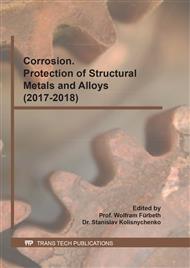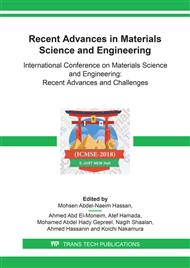p.104
p.119
p.128
p.134
p.149
p.159
p.165
p.174
p.197
Preparation and Characterization of an Emulsion Paint Based on Arghel Extract as an Eco-Friendly Corrosion Inhibitor
Abstract:
Corrosion control of metals is of technical, economical, environmental, and aesthetical importance. The use of inhibitors is one of the best options of protecting metals and alloys against corrosion globally. The environmental toxicity of organic corrosion inhibitors has prompted the search for green corrosion inhibitors which do not contain heavy metals or other toxic compounds. In addition to being environmentally friendly, plant products are inexpensive, readily available and renewable. With the growth of the green movement, it is important to prepare environmentally friendly anticorrosive paints to save lot of money, which are lost each year because of corrosion. This study utilized optical measurements, electrochemical impedance spectroscopy (EIS) analysis, scanning electron microscope (SEM) analysis, immersion test in artificial sea water and morphology observations of Arghel extract (AE) as Eco-friendly corrosion inhibitor incorporated in (styrene-acrylic) emulsion paint. In addition Physical, Chemical and Mechanical Properties of dry paint films of the paint test has been done in absence and presence of the corrosion inhibitor. We found that (styrene-acrylic) emulsion paint with 75ppm AE (SP2) has the best performance in protecting mild steel from corrosion.
Info:
Periodical:
Pages:
149-158
Citation:
Online since:
October 2018
Authors:
Price:
Сopyright:
© 2018 Trans Tech Publications Ltd. All Rights Reserved
Share:
Citation:



